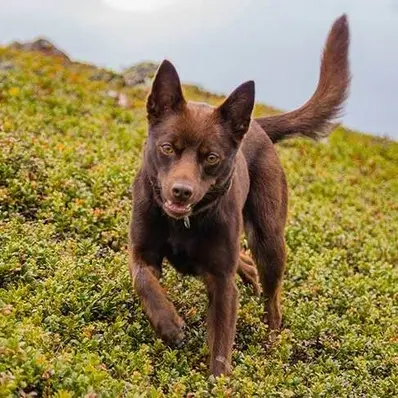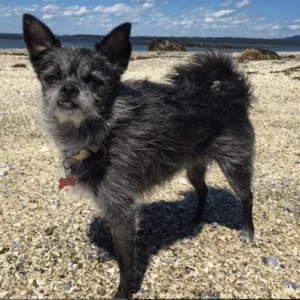Australian Kelpie History/Origin
The Australian Kelpie’s lineage can be traced back to the late 19th century in Australia, when they were developed to work on ranches, herding livestock, particularly sheep.
This herding breed’s creation is attributed to a Scottish immigrant named George Robertson. He is said to have crossed several breeds, including Collies, Dingoes, and Scottish Sheepdogs. He aimed to develop a dog breed that could withstand the harsh climate and landscape of the Australian outback.
Collie- Source: Wikipedia
Dingo- Source: Britannica
The result was the Australian Kelpie, named after the legendary water sprite of Celtic folklore, known for its agility and prowess in herding sheep.
This purebred dog quickly gained popularity among Australian farmers for their unparalleled work ethic and versatility. They were invaluable assets on large pastoral stations, where they tirelessly worked alongside stockmen to gather, drive, and manage livestock over vast distances.
Over time, the work Kelpie’s reputation as a working dog spread beyond Australia, and they gained recognition worldwide for their exceptional herding instincts and trainability.
In 1902, the first Australian Kelpie was officially registered with the Kennel Club of New South Wales. Later, it was recognized by the United Kennel Club and Canadian Kennel Club. However, the American Kennel Club has only registered this breed under the Foundation Stock Service.
Australian Kelpie Personality
The Australian Kelpie is a breed that loves to stay active, both physically and mentally. Because they were originally bred as herding dogs, they have an instinct to stay busy. This means they need plenty of exercise and mental stimulation to keep them happy and healthy.
Taking your Kelpie for a walk or run every day is essential. They also enjoy activities that challenge them mentally, like playing with puzzle toys or learning new tricks.
By keeping them mentally and physically active, you’ll have a happier and more well-behaved dog.
- Australian KelpieTemperament
Australian Kelpies have a unique personality that suits their working heritage. They’re independent thinkers, which is great for tasks like herding sheep.
But as pets, this independence can be tricky. They don’t like being alone for long and may get up to mischief if they’re bored.
Despite this, they are fiercely loyal and always on the lookout. That’s why they make fantastic watchdogs—they’re quick to bark at anything they see as a threat.
Early training and socialization are key to helping them adjust to life at home. They also don’t respond well to rebukes. They may even get sensitive about them, so it’s important to use positive reinforcement when teaching them.
- Potential Challenges
Australian Kelpies possess boundless energy and strong herding instincts, making them great companions for active families. However, without sufficient exercise and mental stimulation, they may exhibit undesirable behaviors like excessive barking or destructive chewing. Their herding instincts can also lead to nipping or attempts to herd family members, requiring careful training and socialization to manage effectively.
Australian Kelpie Physical Appearance
The Australian Kelpie has a sleek and strong body, built for agility and endurance. Their eyes are bright and attentive, while their ears stand up tall to catch sounds easily.
Their head is proportionate with a broad skull and a strong nose. Altogether, these features make them sturdy and smart working dogs.
- Size
They are medium-sized dogs that are well-proportioned and muscular, showcasing their strength and agility.
Typically, male Australian Kelpies stand between 17 to 20 inches at the shoulder, while females typically range from 16 to 19 inches. This size range allows them to be agile and quick on their feet, essential qualities for their role as herding dogs.
- Australian Kelpie Colors
One of the most notable features of the Australian Kelpie is its coat, which comes in a variety of colors. These can include black, chocolate, red, tan, fawn, blue, or cream, often with distinct markings or patterns. Some Kelpies may also have tan or white markings on their chest, legs, or face, adding to their individuality and charm.
Their double coat is typically short and dense, protecting them from the elements while remaining low-maintenance in terms of grooming.
Australian Kelpie Gender Differences
Male Australian Kelpies are generally taller and heavier than females. On average, males stand between 17 to 20 inches tall at the shoulder, while females typically range from 16 to 19 inches.
In terms of weight, males typically weigh between 30 to 60 pounds, whereas females usually weigh slightly less.
But when it comes to personality and trainability, both males and females are pretty much the same. Surprisingly, there aren’t any big differences in terms of health between male and female Australian Kelpies. They both stay pretty healthy throughout their lives.
Australian Kelpie Feed/Nutrition
A balanced and nutritious diet is vital for the health and well-being of your dog. As a highly active breed, they require a diet rich in protein to support their energy needs and muscle development.
Like any breed, they need good quality dog food that is appropriate for their age, size, and activity level.
When feeding Australian Kelpie puppies, it’s crucial to choose a puppy formula that supports their growth and development. Adult Kelpie dogs should consume a diet consisting of lean proteins, healthy fats, and complex carbohydrates.
In addition to their regular diet, you can add supplemental foods such as fruits, vegetables, and occasional treats such as mango. These can provide additional nutrients and variety to their diet but should be given in moderation to prevent digestive upset or weight gain.
Overall, providing a well-balanced diet tailored to the individual needs of this breed is essential for maintaining their health and vitality.
Australian Kelpie Health
Overall, Australian Kelpies are a healthy breed with few genetic health issues. However, they may be prone to some health problems, such as:
- Progressive Retinal Atrophy: PRA is a hereditary condition affecting the eyes, where the cells in the retina gradually degenerate over time. Initially causing night blindness, it progresses to complete blindness. Regular eye check-ups are essential for early detection and management.
- Cerebellar Abiotrophy: Cerebellar abiotrophy is a neurological disorder characterized by the degeneration of cells in the cerebellum, leading to movement coordination difficulties, tremors, and balance problems. While there is no cure, supportive care and therapies can help affected dogs lead fulfilling lives.
- Hip Dysplasia: Hip dysplasia is a common orthopedic condition where the hip joint develops abnormally, leading to pain, inflammation, and eventually arthritis. Symptoms include lameness, reluctance to move, and difficulty getting up. Management often involves medication, weight control, and, in severe cases, surgical intervention.
Regular vet check-ups and a healthy lifestyle can help prevent and manage these potential health concerns.
Australian Kelpie Care and Grooming
Taking care of an Australian Kelpie’s coat is pretty low-maintenance because it’s short and dense.
Brushing once a week helps to keep shedding under control and their fur looking neat. Use a slicker brush or grooming mitt to remove loose hair and prevent tangles. They might need more frequent brushing and care during shedding season.
Don’t forget to trim their nails and clean their ears too, to keep them healthy and comfortable. It’s also important to take care of their teeth by giving them dental chews or brushing their teeth regularly.
Finally, remember to keep up with your Kelpie’s overall healthcare needs, including vaccinations, parasite prevention, and regular check-ups with a veterinarian. Also, invest time in leash training your dog to ensure enjoyable and safe walks.
Buy or Adopt Australian Kelpie
If you’re considering Australian Kelpie adoption, there are many rescue organizations dedicated to finding loving homes for dogs in need.
Australian Kelpie Price
The average Australian Kelpie price ranges from $500 to $1500. When purchasing a dog of this breed from a breeder, it’s important to buy from a reputable breeder.
Interesting Facts
- In the 20th century, multiple red Australian Kelpies were named Red Cloud. One of the most popular Red Cloud Kelpies was Gunner, who played his part in alerting Allied air forces of enemies approaching planes during WWII.
- A 2011 movie named Red Dog was made about a Kelpie-Cattle dog mix who was known for his travels throughout the Pilbara region. The movie featured a red Australian Kelpie who played the role of Koko.
Red Dog Movie-Source: Wikipedia
Best For
Australian Kelpies are ideal for active individuals or families who love outdoor activities. They make loyal companions and excel in dog sports and competitions, making them a great choice for those seeking an intelligent and versatile pet.
Top Names
| Male Australian Kelpie Names | Female Australian Kelpie Names |
| Ace | Luna |
| Blaze | Willow |
| Maverick | Zoey |
| Ranger | Ruby |
| Thor | Sadie |









 Collie- Source:
Collie- Source:  Dingo- Source:
Dingo- Source: 

 Black Australian Kelpie -Source:
Black Australian Kelpie -Source:  Chocolate Australian Kelpie -Source:
Chocolate Australian Kelpie -Source:  Black and Tan Australian Kelpie -Source:
Black and Tan Australian Kelpie -Source: 
 Red Dog Movie-Source:
Red Dog Movie-Source: 






